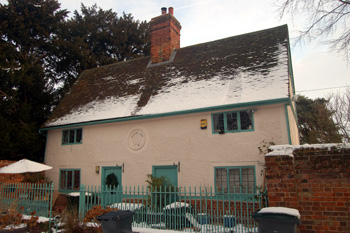
325 Church Lane Christmas Eve 2010
325 Church Lane was listed by the former Ministry of Public Buildings and Works in July 1964 as Grade II, of special interest. A circular plaque records the date the house was built as 1762, by John Howard who lived next door at Howard House. It was a pair of almshouses and was restored by Samuel Howard Whitbread in 1928. The house stands on a brick plinth and is built of colour washed roughcast over a timber frame, having an old clay tiled roof. The two almshouses had just a single room upstairs and down.
We are fortunate that three surveys of the parish of Cardington from the late 18th century survive. The first of these was undertaken in 1782 by James Lilburne. He was the parish schoolmaster and later agent for Samuel Whitbread, who owned large estates in the parish and also the sole Enclosure Commissioner for the parish. He produced a list of all the inhabitants of the parish arranged by house and hamlet [P38/28/1]. This was published, with extensive analysis by County Archaeologist David Baker in 1973 as Bedfordshire Historical Record Society Volume 52.
Since publication a second list has been found [P38/28/2]. It carries revisions up to the year 1789. Sadly neither of these surveys includes a map. Finally, in 1794 Lilburne produced another survey [W2/6/1-3] and this one had a map with a key showing where each house was. One can use this to plot the houses of the previous surveys and this work was carried out by John Wood of Bedfordshire County Council’s Conservation Section in October 1982 [CRT130Cardington29].
The survey of 1782 records that 325 Church Lane was a cottage divided into two tenements and was in the occupation of Mary Beckles and Esther Tomson, two widows, and their families [P38/28/1/2]. Mary Beckles, née Crawley had been born in Cardington and was 65 years old. She spun Jersey, a woollen fabric predominantly used for underwear. She was willing to be inoculated against smallpox if others in the village were. Her daughter was 21 year old Ann, who made lace. She married Thomas Bass, a labourer from Cople in 1783 and died on 30th August that year. Her husband married again in 1784 as his second wife Ann was living at the premises on 1st January that year. She was then 22 and had been born Ann Osborn in Ridgmont. She, too, made lace. The couple’s child Mary was born on 13th August 1785. In 1787 Mary Beckles moved into one of the new almshouses built by Samuel Whitbread I on The Green. The 1794 survey [W6/2/1-3] shows Widow Serjeant in residence in her place, presumably her son-in-law and his family had also moved out of 325 Church Lane by then.
Esther Tomson’s maiden name had been Hoppy and she had been born at Gransden in Cambridgeshire. She was 57 years old and, like her neighbour, spun Jersey. She had had smallpox prior to May 1787. Her daughter was also named Esther and was 15. She had been schooled at the expense of Samuel Whitbread. On 5th June 1787 she married John Redman, perhaps a relative of the John Redman who lived at 324 Church Lane. He was a 21 year old shoemaker who had been born in Cardington and then lived at Cotton End. Their son, another John, was born on 3rd March 1788. She was willing to be inoculated against smallpox. Esther senior was still living in the tenement in 1794 [W6/2/1-3].
The Rating and Valuation Act 1925 specified that every building and piece of land in the country was to be assessed to determine its rateable value. Cardington, like most of the county, was assessed in 1927 and the valuer visiting 325 Church Lane [DV1/C116/7] found it owned by the Whitbread Estate and occupied by B. Fuller whose rent was taken straight from his wages as an employee of the estate.
His accommodation comprised two living rooms, two sculleries and two bedrooms (“big”). A washhouse stood outside. The valuer commented: “was two cottages”.